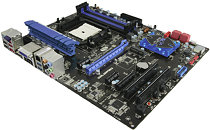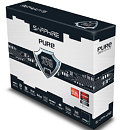Thursday, July 21st 2011

Sapphire Announces Pure Platinum A75 Motherboard for AMD A-Series APUs
SAPPHIRE Technology, a leading manufacturer and global supplier of graphics, mainboard and multimedia solutions has just introduced a new mainboard developed to support the latest A-series Fusion APU family from AMD.
AMD's A-series APUs combine - on a single chip - a Quad core CPU, interface circuitry equivalent to a Northbridge and a DX11 graphics core equivalent to a desktop level graphics card, and also incorporating a 3rd-generation UVD (universal video decoder) for the accelerated decoding of HD and Blu-ray content, including stereoscopic 3D support. This APU series together with the A75 chipset, which has native support for the latest interface standards, such as SATA 6G and USB 3.0 as well as USB 2.0 and PCI-Express Gen2, makes a powerful combination that delivers all the features required in a state-of-the-art PC.The SAPPHIRE Pure Platinum A75 is a full ATX sized board making full use of the combined features of the A75 chipset and A-series APU. Four dual channel memory sockets are provided, supporting up to 16GB of DDR3 memory with current technology, and capable of supporting up to 32GB when suitable modules become available. There are four onboard USB 3.0 ports (two at the rear) as well as four USB 2.0 ports (8 including headers), as well as Gigabit LAN and Bluetooth connectivity with EDR (enhanced data rate). It has five SATA 6G ports, including AHCI and RAID support, and a SATA 3G port brought out to the rear panel on an eSATA connector.
Three Video output options are provided for the graphics output of the APU - DVI, HDMI and DisplayPort - of which any pair can be used simultaneously. The HDMI 1.4a port supports both video and audio, including stereoscopic 3D output. The rear panel also has the standard I/O configuration for the on board HD 7.1 Audio.
Extensive expansion support is provided by two standard PCI slots as well as one PCI-E Gen2 x4 slot, two PCI-E Gen2 x1 slots, and one mini-PCI-E x1 (Gen2) connector for modules in this new format such as wireless network cards. All this in addition to one PCI-E Gen2 x16 slot, compatible with an add-in graphics card. When a suitable graphics card is fitted, such as a member of the SAPPHIRE HD6600 or SAPPHIRE HD 6500 series, the SAPPHIRE Pure Platinum A75 supports Dual Graphics - that means that the graphical performance of the APU combines with the performance of the add-in card to achieve up to 175% of the performance of the APU graphics alone.
Many user friendly features have been incorporated in the SAPPHIRE Pure Platinum A75, such as digital debug display and a push button reset for the BIOS, as well as start and system reset buttons. These are especially useful for enthusiasts interested in performance tuning or overclocking. The board has a Dual BIOS, allowing for experimentation and updates, and for the hard-core enthusiast, voltage test pads have been brought out to the edge of the board for the critical voltages on the APU and memory circuits.
The build quality of the SAPPHIRE Pure Platinum A75 is high. It has a black multilayer PCB, and uses high quality gold plated connectors for USB 3.0 and LAN. It incorporates many of the high end features associated with the SAPPHIRE brand, such as the use of high reliability solid capacitors throughout. The multi-phase voltage regulation circuitry for both the APU and memory modules incorporate the patented SAPPHIRE Diamond Black chokes with coolers that have featured on SAPPHIRE's high end graphics cards.
Hardware monitoring tools and the SAPPHIRE proprietary Mainboard TriXX software allow users to review and adjust a range of system parameters while optimising performance of the APU and A75 chipset.
The SAPPHIRE Pure Platinum A75 is in production now, and will be available through SAPPHIRE's usual channel partners and retailers.
AMD's A-series APUs combine - on a single chip - a Quad core CPU, interface circuitry equivalent to a Northbridge and a DX11 graphics core equivalent to a desktop level graphics card, and also incorporating a 3rd-generation UVD (universal video decoder) for the accelerated decoding of HD and Blu-ray content, including stereoscopic 3D support. This APU series together with the A75 chipset, which has native support for the latest interface standards, such as SATA 6G and USB 3.0 as well as USB 2.0 and PCI-Express Gen2, makes a powerful combination that delivers all the features required in a state-of-the-art PC.The SAPPHIRE Pure Platinum A75 is a full ATX sized board making full use of the combined features of the A75 chipset and A-series APU. Four dual channel memory sockets are provided, supporting up to 16GB of DDR3 memory with current technology, and capable of supporting up to 32GB when suitable modules become available. There are four onboard USB 3.0 ports (two at the rear) as well as four USB 2.0 ports (8 including headers), as well as Gigabit LAN and Bluetooth connectivity with EDR (enhanced data rate). It has five SATA 6G ports, including AHCI and RAID support, and a SATA 3G port brought out to the rear panel on an eSATA connector.
Three Video output options are provided for the graphics output of the APU - DVI, HDMI and DisplayPort - of which any pair can be used simultaneously. The HDMI 1.4a port supports both video and audio, including stereoscopic 3D output. The rear panel also has the standard I/O configuration for the on board HD 7.1 Audio.
Extensive expansion support is provided by two standard PCI slots as well as one PCI-E Gen2 x4 slot, two PCI-E Gen2 x1 slots, and one mini-PCI-E x1 (Gen2) connector for modules in this new format such as wireless network cards. All this in addition to one PCI-E Gen2 x16 slot, compatible with an add-in graphics card. When a suitable graphics card is fitted, such as a member of the SAPPHIRE HD6600 or SAPPHIRE HD 6500 series, the SAPPHIRE Pure Platinum A75 supports Dual Graphics - that means that the graphical performance of the APU combines with the performance of the add-in card to achieve up to 175% of the performance of the APU graphics alone.
Many user friendly features have been incorporated in the SAPPHIRE Pure Platinum A75, such as digital debug display and a push button reset for the BIOS, as well as start and system reset buttons. These are especially useful for enthusiasts interested in performance tuning or overclocking. The board has a Dual BIOS, allowing for experimentation and updates, and for the hard-core enthusiast, voltage test pads have been brought out to the edge of the board for the critical voltages on the APU and memory circuits.
The build quality of the SAPPHIRE Pure Platinum A75 is high. It has a black multilayer PCB, and uses high quality gold plated connectors for USB 3.0 and LAN. It incorporates many of the high end features associated with the SAPPHIRE brand, such as the use of high reliability solid capacitors throughout. The multi-phase voltage regulation circuitry for both the APU and memory modules incorporate the patented SAPPHIRE Diamond Black chokes with coolers that have featured on SAPPHIRE's high end graphics cards.
Hardware monitoring tools and the SAPPHIRE proprietary Mainboard TriXX software allow users to review and adjust a range of system parameters while optimising performance of the APU and A75 chipset.
The SAPPHIRE Pure Platinum A75 is in production now, and will be available through SAPPHIRE's usual channel partners and retailers.




27 Comments on Sapphire Announces Pure Platinum A75 Motherboard for AMD A-Series APUs
Im glad, that they still have backwards compability in mind,as it makes troubleshooting much easier, and i hope, that they will keep at least a single pci slot, on most of the boards, for a very long time.;)
And I agree about the PCI, it is quite useful, not two them maybe, but come on... this board doesn't do a quad CFX or SLI, it is for mere people that have plenty of PCI devices left, like sound cards or additional USB, legacy I/O for instruments. (I still use them instead of integrated, why? Because if there is a defective device you'll blow the card not the whole bridge out).
Also, I see FAIL. The 4th PCI-e slot has an open end, but the CMOS battery is right next to it. That must be Sapphire's way of telling us, "We leave you the option of inserting a x8, or x16, card in there, but you won't want to do it". :laugh:
This mobo doesn't look too cool and all however dual graphics idea and the 175% boost seem nice.
the motherboard market getting crowded, what they offer to us that different from other brand?
I also would like to see more of them again:)
PCIe purists keep bringing it up in hopes that some manufacturer will hear our plea! If you look at newegg.com there are 21 FM1 boards available. All of them have PCI. 12 with one slot, 5 with two slots, and 4 with three slots. We have to compromise while those who want X number of PCI slots have multiple options available to them.
Perhaps this is why I like ITX so much, and am waiting for the ITX FM1 boards (Asus, ASrock) to ship to retailers. Only one slot and it's PCIe x16!
EDIT: I'm just poke'n fun at you buddy! Don't hate on the Weaver..hehehe :toast:
EDIT:
Also not necessarily owned by Asus, more like these comparisons:
Phillip Morris: Marlboro & Basic
WWE Branding: Raw & Smackdown!
More like a sister company so to speak. I think they are the same board manufacturing plants but different bios engineers and onboard components.
You buy a top of the range super duper high end mobo, place all the high end latest components around it and get annoyed by useless PCI slot on the mobo wasting space where i could have a PCIe soundcard. Instead i have to place it tight next to graphic card where it blocks half of the airflow. Not cool at all. If i turn them around, they have some more space between but then the graphic card is again at the very bottom with crippled airflow again.
If we got rid of much newer AGP and also PATA connectors, why the hell we still have this archaic PCI slot on the modern boards. Last time i used PCI was with X-Fi Xtreme Music back in 2005. And even back then i was thinking, man when will they migrate this to PCIe...
Now, nearly 7 years later, PCI is still around (it's a 18 years old bus), collecting dust and pissing me off. Sorry, but i see absolutely no point in keeping it around. Plus it should be the other way around.
If YOU don't like the lack of PCI enabled mobo, then don't buy the PCIe one. Because quite frankly it's time for PCI to retire. If you have money to buy a brand new high end mobo you're also able to replace that ancient soundcard or whatever with a modern PCIe one.
If you don't like that fact then it's tough luck. With your thinking we'd still be using Core i7 on Socket 1... it's just time to move on.
Still pricing is a bit high and this is to be expected with a new cpu and motherboard. I expect prices drops late 2011 early 2012.
Stop passing the Kool-Aid :toast:
This is what i think makes this product stand out from the rest, should make for some interesting benchies:)
people still use WIN XP so i think pci is still ok, you do have more choices so dont complain.
Sure, it's a nice board with a decent set of features. For those looking for a FM1 ATX board on a low-budget this will be a top contender.